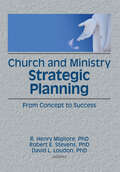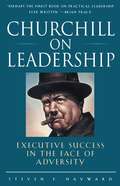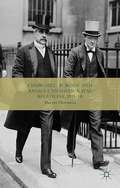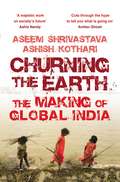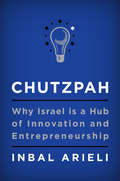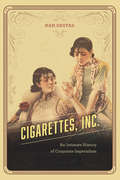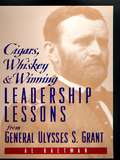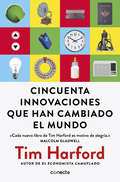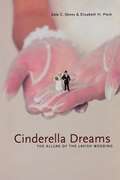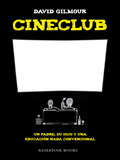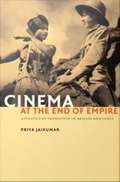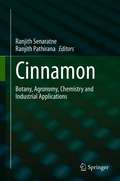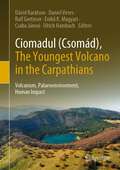- Table View
- List View
Church and Ministry Strategic Planning: From Concept to Success
by David L Loudon Robert E Stevens William Winston R Henry MiglioreSpiritual management is required for spiritual organization, and yet a ministry’s master plan should be the Master’s plan for that ministry. Church and Ministry Strategic Planning assists readers in developing a Biblically based blueprint for carrying out the many activities in which the church or ministry is involved. The authors show clearly how careful planning is inspired by the Scriptures (“Suppose one of you wants to build a tower. Will he not first sit down and estimate the cost to see if he has enough money to complete it?”--Luke 14:28) and how it improves making decisions today which ultimately affect the ministry’s effectiveness tomorrow.Church and Ministry Strategic Planning covers all areas of this type of planning and can be read and reviewed quickly. Through the use of a model of the strategic planning process, the authors show how to develop mission statements, define strategic objectives, develop strategy options and operating strategies, appraise performance, and monitor strategic planning. Readers are led step-by-step through these key areas of creating a strategic plan. Examples and worksheets at the end of each chapter enable pastors, administrators, and lay leaders to develop a strategic plan fitting to their specific ministry or church. The appendixes provide tools used in planning as well as a complete sample strategic plan for a large church. Put these concepts to immediate use in decisionmaking and pursue God’s purpose and vision for the church or ministry. If readers take the time and effort to study this book, apply its format, and prayerfully keep God in every step of the plan, here is what the authors believe plan administrators can expect:1. A sense of enthusiasm in the church or ministry 2. A 5-year plan in writing to which everyone is committed 3. A sense of commitment by the entire church to its overall direction 4. Time for the leaders to do what they have been called to do 5. Clear job duties and responsibilities 6. Clear and evident improvement in the health and vitality of every member of the church staff 7. Measurable improvement in the personal lives of all those in responsible positions with time for vacations, family, and personal pursuits 8.The ability to measure very specifically, the growth and contribution made by senior pastors or evangelists at the close of their careers 9. Guaranteed leadership of the church or ministry because a plan is in place--in writing--and is understood. Even more importantly, a management team and philosophy will be in place to guide the church or ministry into its next era of growthExplore this Biblical perspective on planning and develop a strategic plan that is systematic and continuous and allows the church or ministry to assess its market position, establish goals, objectives, priorities, and strategies to be completed within specified time periods, achieve greater staff and member commitment and teamwork aimed at meeting challenges and solving problems, and muster its resources to meet these changes through anticipation.
Churchill on Leadership: Executive Success in the Face of Adversity
by Steven F. HaywardSuccess often depends on the strength of a single quality: leadership. Winston Churchill is universally recognized as one of the 20th century's great political leaders and his words ring just as true in the world of commerce. A wise, witty, and inspiring leader, Churchill ran Great Britain like a great corporation. "Perhaps the finest book on practical leadership ever written." -- Brian TracyChurchill on Leadership demonstrates that the principles that guided Churchill ably translate to private industry today. Author Steven F. Hayward gives strong evidence that, if you remove Churchill from his political context, he would have the resume to be among the great business leaders of any age. Churchill: * was a financier (as chancellor of the Exechequer) and labor negotiator (as home secretary)* managed a large transportation network (as head of the British Navy) and far-flung property holdings (as colonial secretary)* persevered through bankruptcies and other financial disasters* conceived and introduced innovative new products over the opposition of his colleagues, and reorganized major production operations in the midst of crisis. With wit and insight, Hayward reveals Churchill's secrets for business success from assembling and inspiring a first-rate team to preparing a wise budget, from communicating a vision to structuring effective meetings, from acting decisively to rebounding from a failure. Laced with epochal events from the historical stage, enlivened with stimulating speculation, and leavened with wit, Churchill on Leadership is both an enjoyable read and a thought-provoking lesson on leadership.From the Trade Paperback edition.
Churchill, Borden and Anglo-Canadian Naval Relations, 1911–14
by Martin ThorntonIn 1911, Winston S. Churchill and Robert L. Borden became companions in an attempt to provide naval security for the British Empire as a naval crisis loomed with Germany. Their scheme for Canada to provide battleships for the Royal Navy as part of an Imperial squadron was rejected by the Senate with great implications for the future.
Churning the Earth: The Making of Global India
by Aseem ShrivastavaThe world stands so dazzled by India's meteoric economic rise that we hesitate to acknowledge its consequences to the people and the environment. In Churning the Earth, Aseem Shrivastava and Ashish Kothari engage in a timely enquiry of this impressive growth story. They present incontrovertible evidence on how the nature of this recent growth has been predatory and question its sustainability. Unfettered development has damaged the ecological basis that makes life possible for hundreds of millions resulting in conflicts over water, land, and natural resources, and increasing the chasm between the rich and the poor, threatening the future of India as a civilization.
Chutzpah: Why Israel Is a Hub of Innovation and Entrepreneurship
by Inbal ArieliDiscover the secret behind how Israel, a tiny country with the highest concentration of start-ups per capita worldwide, is raising generations of entrepreneurs who are disrupting markets around the globe and bringing change to the world.Dubbed “Silicon Wadi,” Israel ranks third in the World Economic Forum Innovation Rating. Despite its small size, it attracts more venture capital per capita than any other country on the planet. What factors have led to these remarkable achievements, and what secrets do Israeli tech entrepreneurs know that others can learn? Tech insider Inbal Arieli goes against the common belief that Israel’s outstanding economic accomplishments are the byproduct of its technologically advanced military or the result of long-standing Jewish traditions of study and questioning. Rather, Arieli gives credit to the unique way Israelis are raised in a culture that supports creative thinking and risk taking. Growing up within a tribal-like community, Israelis experience childhoods purposely shaped by challenges and risks—in a culture that encourages and rewards chutzpah. This has helped Israelis develop the courage to pursue unorthodox, and often revolutionary, approaches to change and innovation and is the secret behind the country’s economic success.While chutzpah has given generations of Israelis the courage to break away from conventional thinking, the Israeli concept balagan—messiness in Hebrew—is at the root of how Israelis are taught to interact with the world. Instead of following strict rules, balagan fosters ambiguity, encouraging the development of the skills necessary for dealing with the unpredictability of life and business. Living with balagan provides Israelis with the opportunity to constantly practice the soft skills defined by the World Economic Forum as the Skills for the Future, as balagan promotes creativity, problem-solving, and independence—key characteristics of successful entrepreneurs.By revealing the unique ways in which Israelis parent, educate and acculturate, Chutzpah offers invaluable insights and proven strategies for success to aspiring entrepreneurs, parents, executives, innovators, and policymakers.
Château Margaux: Launching the Third Wine (Abridged)
by Elie OfekChâteau Margaux, one of only five prestigious estates in the Bordeaux Medoc wine region to have been classified as a "first-growth", is facing a host of strategic decisions in early 2013. Up until this point the estate had been selling two red wines, a first wine whose retail price often exceeded $1000 a bottle, and a second wine whose retail price often exceeded $200 a bottle. Owner Corinne Mentzelopoulos and her management team were now preparing to launch a new third wine made from the estate's production not used to make the first two. They have to decide whether the best go-to-market strategy is to sell the third wine to the local Bordeaux merchants and relinquish commercialization to them or to devise a complete marketing plan for the new wine that includes: target market selection, positioning, quantity to release, pricing, channel structure and brand name. Mentzelopoulos was considering the optimal marketing for the third wine in light of moves by other first-growths, such as purchase of vineyards in the Bordeaux region, selling mass-market wines, and global expansion.
Cigarettes, Inc.: An Intimate History of Corporate Imperialism
by Nan EnstadTraditional narratives of capitalist change often rely on the myth of the willful entrepreneur from the global North who transforms the economy and delivers modernity—for good or ill—to the rest of the world. With Cigarettes, Inc., Nan Enstad upends this story, revealing the myriad cross-cultural encounters that produced corporate life before World War II. In this startling account of innovation and expansion, Enstad uncovers a corporate network rooted in Jim Crow segregation that stretched between the United States and China and beyond. Cigarettes, Inc. teems with a global cast—from Egyptian, American, and Chinese entrepreneurs to a multiracial set of farmers, merchants, factory workers, marketers, and even baseball players, jazz musicians, and sex workers. Through their stories, Cigarettes, Inc. accounts for the cigarette’s spectacular rise in popularity and in the process offers nothing less than a sweeping reinterpretation of corporate power itself.
Cigars, Whiskey And Winning: Leadership Lessons From General Ulysses S. Grant
by Al KaltmanDrawing on Grant's writings and life experiences during his meteoric rise from tannery clerk to commanding general of over one million men, "Cigars, Whiskey & Winning" presents 250 concise, practical lessons for getting superior performance from the troops, whether military or corporate. An inspiring management treatise torn from the pages of Civil War history, this unique book goes beyond mere 'how-to's' to reveal the character traits, core beliefs, and fundamental values that turn a manager into a leader, whether on the battlefield or in the boardroom. "Cigars, Whiskey & Winning" is a savvy blend of biography, history, and leadership wisdom that will appeal to aspiring business leaders and Civil War buffs alike.
Cilkray Graphics
by Frank V. Cespedes Alisa ZaloshMarcus Crosby, President of Cilkray Graphics, convened an emergency meeting with Cilkray's senior managers in order to respond to an unexpected development. Cilkray sold three lines of specialized graphics processing units (GPUs). Each line targeted a segment of the professional market for Hosted Virtual Desktops (HVDs). Grovex, Cilkray's key competitor, had just announced the impending launch of the GSpeed, a new GPU. It said that the GSpeed would exceed the performance of competitive products, including Cilkray's most advanced product line, the CP3000. Industry rumors suggested that the GSpeed's price would be 20% to 30% below that of the CP3000. Crosby and his team saw two options. Cilkray could drop the CP3000's price immediately. It could also delay its planned release of its new CK300, scheduled for December 2013, in order to make its products more competitive. Crosby and his team had to decide what Cilkray should do next.
Cincinnati Candy: A Sweet History
by Dann WoellertFor more than a century, Cincinnati’s candy industry satisfied our national sweet tooth. Stick and drop candies appeared here long before their Civil War popularity. Opera creams, rich fondant-filled chocolate candy brought here by Robert Hiner Putman, provided decadence. Candy corn, which the Goelitz Company introduced to the United States before World War I, remains a ubiquitous treat. Marpro Products created and popularized the marshmallow cone candy. Doscher invented the French Chew and made caramel corn a baseball concession at Redland Field decades before Cracker Jack became synonymous with our national pastime. The city’s many Greek and Macedonian immigrants influenced the unique Queen City tradition of finishing a Cincinnati-style “threeway” of spaghetti, chili and cheddar with a chocolate mint. Local food etymologist Dann Woellert tells these stories and more in this delectably sweet history.
Cincinnati Children's Hospital Medical Center
by Amy C. Edmondson Anita TuckerThe case describes an organization's use of the science of improvement to transform their process quality from below average to the top 10% in their industry. The case outlines the protagonist's strategy of developing internal experts who are trained in a common methodology for making improvement and spreading these ideas in their work units.
Cincuenta innovaciones que han cambiado el mundo
by Tim HarfordA través de las fascinantes historias de cincuenta ideas e inventos, el autor de El economista camuflado explica en este nuevo libro cómo la innovación puede cambiar nuestras vidas y alterar el complejo sistema económico global. Hay innovaciones, ideas e inventos que permiten curar el cáncer. Otras nos permiten llegar a nuestros destinos de vacaciones mucho más deprisa. Son divertidas. Generan dinero. Y, por descontado, los inventos tienen éxito porque resuelven un problema que alguien, en algún lugar, quiere resolver. El arado, por ejemplo, tuvo éxito porque ayudó a los agricultores a producir más comida con menos esfuerzo. Sin embargo, los inventos configuran nuestra vida de manera impredecible, y, mientras resuelven un problema para alguien, a menudo crean un problema para otra persona. ¿Por qué el código de barras cambió el equilibrio de poderes en la industria alimentaria? ¿Por qué el gramófono incrementó la desigualdad económica? ¿Y cómo el alambre de púas forjó el futuro de Estados Unidos? Las innovaciones también afectan a una compleja red de conexiones económicas. A veces nos complican la vida, otras rompen viejos límites y, en ocasiones, crean patrones completamente nuevos. ¿Por qué, por ejemplo, la píldora anticonceptiva incrementó el número de mujeres en las facultades de Medicina y Derecho? Con el talento de le ha convertido en el más célebre divulgador económico, Tim Harford describe el funcionamiento de la economía a través de la sorprendente historia del plato precocinado, el Estado del Bienestar, la dinamo, la estantería Billy, la propiedad intelectual, el iPhone, las maquinillas y hojas de afeitar, el papel moneda o los paraísos fiscales. Algunas de estas historias se centran en fuerzas económicas vastas e impersonales; otras son relatos del genio o la tragedia de los humanos. Como el intento de desarrollar un «rayo mortífero» que, en cambio, llevó a inventar el radar, un dispositivo esencial para que los viajes aéreos sean seguros. Y todas estas innovaciones nos cuentan una historia, no solo del ingenio humano, sino también de los sistemas invisibles que nos rodean: de las cadenas de suministro global, de la información omnipresente, del dinero y de las ideas. Y, al final del libro, podremos aunar todas estas lecciones para preguntarnos cómo deberíamos pensar en la innovación hoy en día. ¿Cuáles son las mejores maneras de alentar nuevas ideas? ¿Y cómo podemos pensar con claridad sobre qué efectos pueden tener estas ideas y actuar con previsión para maximizar los beneficios y mitigar prejuicios?
Cinderella Dreams: The Allure of the Lavish Wedding
by Elizabeth H. Pleck Cele C. OtnesFor anyone who has ever wondered about the meanings behind a white dress, a diamond ring, rice, and traditions such as cake cutting, bouquet tossing, and honeymooning, this book offers an entertaining and enlightening look at the historical, social, and psychological strains that come together to make the lavish wedding the most important ritual in contemporary consumer culture.
Cineclub
by David GilmourFue un trato muy poco convencional: Jesse podía dejar de ir al instituto, dormir todo el día, no trabajar, no pagar alquiler pero a cambio tenía que mantenerse alejado de las drogas y ver tres películas a la semana con su padre, el crítico de cine canadiense David Gilmour. Jesse aceptó de inmediato y al día siguiente padre e hijo comenzaron con la primera película de la lista: Los cuatrocientos golpes de François Truffaut. A lo largo de tres años padre e hijo vieron todo tipo de películas, desde las consideradas joyas del cine hasta los grandes bodrios de todos los tiempos. Con el trasfondo de El padrino, Instinto básico, Showgirls, Ciudadano Kane o La ley del silencio, David y Jesse hablan de los principales directores de cine, de las escenas célebres y de los actores que las protagonizaron, y poco a poco sobre todo tipo de temas: chicas, música, mal de amores, trabajo, drogas, talento, dinero, amor, amistad... Cineclub es un repaso personal de la historia del cine, un desafío a nuestras nociones de la educación y, sobre todo, la historia real y conmovedora acerca de cómo un padre y un hijo sortearon una época muy especial en su relación; en la que los hijos se encierran en sí mismos y los padres pierden la oportunidad de llegar a ellos. Esta es la historia de una decisión que lo cambió todo.
Cinema at the End of Empire: A Politics of Transition in Britain and India
by Priya JaikumarHow did the imperial logic underlying British and Indian film policy change with the British Empire's loss of moral authority and political cohesion? Were British and Indian films of the 1930s and 1940s responsive to and responsible for such shifts? Cinema at the End of Empire illuminates this intertwined history of British and Indian cinema in the late colonial period. Challenging the rubric of national cinemas that dominates film studies, Priya Jaikumar contends that film aesthetics and film regulations were linked expressions of radical political transformations in a declining British empire and a nascent Indian nation. As she demonstrates, efforts to entice colonial film markets shaped Britain's national film policies, and Indian responses to these initiatives altered the limits of colonial power in India. Imperially themed British films and Indian films envisioning a new civil society emerged during political negotiations that redefined the role of the state in relation to both film industries. In addition to close readings of British and Indian films of the late colonial era, Jaikumar draws on a wealth of historical and archival material, including parliamentary proceedings, state-sponsored investigations into colonial filmmaking, trade journals, and intra- and intergovernmental memos regarding cinema. Her wide-ranging interpretations of British film policies, British initiatives in colonial film markets, and genres such as the Indian mythological film and the British empire melodrama reveal how popular film styles and controversial film regulations in these politically linked territories reconfigured imperial relations. With its innovative examination of the colonial film archive, this richly illustrated book presents a new way to track historical change through cinema.
Cinema: From the Silent Screen to the Hollywood Blockbuster
by Graham TarrantThis fascinating miscellany is packed with profiles of the heroes and villains of film, explorations of genre, statistics and infographics -perfect for any movie buff who loves the silver screen.
Cinema: From the Silent Screen to the Hollywood Blockbuster
by Graham TarrantThis fascinating miscellany is packed with profiles of the heroes and villains of film, explorations of genre, statistics and infographics -perfect for any movie buff who loves the silver screen.
Cinemex
by James L. HeskettThe founders of Cinemex, the largest capitalized venture start-up in Mexican history, are debating several issues concerning the operations of their new chain of motion picture theatres in Mexico City. The first concerns whether some seats should be left unsold to improve customer service. The second involves limits on advertising to be shown at each presentation. Others include possible investment in an expanded ticketing service and live entertainment.
Cinepolis
by Joshua D. Margolis Fernanda MiguelTwo weeks after Cinepolis released a documentary film about corruption, a judge ordered its provisional suspension, claiming it had to be edited before it continued to be shown, against Mexican cinematography laws. Cinepolis, Latin America's largest movie theater chain and the fourth largest in the world, welcoming 134 million moviegoers in 2011, had never distributed a film in its 40-plus years of existence, nor had there ever been an instance of pro-bono distribution in Mexico. Presumed Guilty, the country's highest grossing documentary, not only achieved commercial success but also fueled a revolution in Mexico's judicial system. Alejandro (as he was called by everyone who worked with him) knew he faced a difficult decision. What risks would Cinepolis run if he chose to fight for freedom of speech? How far was he willing to take such a fight?
Cinnamon: Botany, Agronomy, Chemistry and Industrial Applications
by Ranjith Senaratne Ranjith PathiranaCinnamon is the common name for the spice obtained from the dried inner bark of several species of the genus Cinnamomum in the Lauraceae family. In world trade, Cinnamomum cassia (L.) J. Presl Cinnamomum burmannii dominate, but it is of a different quality to ‘true’ or ‘Ceylon’ cinnamon produced from Cinnamomum zeylanicum Blume (C. verum J. Presl), with the latter much easier to process, giving a more delicate, sweeter flavor with nuances of clove, but more importantly with only traces (often below detection thresholds) of coumarin, compared with 5–7 g/kg in other species. Cinnamon has been a popular and expensive spice in many civilizations, including ancient Egypt, Rome and in 14th and 15th century Europe, where it was used primarily to preserve meat for its antibacterial properties, fine aroma and flavor. Ancient Egyptians used cinnamon in mummification process due to its antibacterial properties and fragrance. The quest for cinnamon brought many explorers to Ceylon, whose ancient history is intertwined with the cinnamon trade. Ancient Egyptians and Romans used cinnamon as a valued spice and as an incense.In recent years, much research has been conducted in crop improvement, processing and value addition in cinnamon. In addition to direct use as a condiment/spice, cinnamon has found a multitude of uses in the food and beverage, traditional medicine, pharmacology, nutraceutical and cosmetics industries. Ceylon cinnamon is unique in that oils distilled from the bark (major constituents are cinnamaldehyde and oleoresins), leaf (eugenol is the major constituent used in dentistry, perfumes, flavorings and as an antioxidant) and roots (camphor) have different industrial uses. Cinnamaldehyde is now a proven natural bactericide widely used in food and beverage industry, effective against Salmonella spp. and Escherichia coli. Thus, it has become an important natural component of organic fruit and vegetable juices to enhance microbial safety of these nutritious beverages.Because of its manifold uses, cinnamon is an important crop. There have been many recent publications on its ethnobotany, genetics, crop improvement, agronomy, processing, biotechnology, chemistry, food and medicinal uses, and industrial applications. However, one book condensing all these findings is lacking. Our publication, with chapters devoted to all these aspects of cinnamon written by experts in these fields, condenses current knowledge into a single source and contribute to the advancement and dissemination of knowledge and technology. Contributors to the book constitute internationally renowned senior scientists and academics with hands-on experience as well as movers and shakers of industry, thereby striking a right balance between theory and practice. Therefore it is a valuable source for students, teachers, scientists, planners policy makers, practicing agriculturists and industrialists, and a prized acquisition to any library in higher education institutions, R & D institutions and public and private sector institutions in agriculture and allied fields.
Cintas y Lazos, Inc.
by David F. HawkinsA recent Cuban immigrant establishes a new notions store. The initial 3-month, GAAP-based income statement differs from one prepared by an economist friend. The store owner wants to know why one shows a profit and the other a loss.
Ciomadul (Csomád), The Youngest Volcano in the Carpathians: Volcanism, Palaeoenvironment, Human Impact
by Dávid Karátson Daniel Veres Ralf Gertisser Enikő K. Magyari Csaba Jánosi Ulrich HambachThis book delivers the present state-of-the-art of scientific characteristics of the unique Ciomadul volcano (Romania, East-Central Europe) from as many aspects as possible.. Multidisciplinary research results obtained on this geologically young volcanic complex are presented to a wider audience (geologists, volcanologists, botanists, archaeologists, historians and teachers). Moreover, the book provides information at a general level for interested laypersons and decision-makers. The first part of the book, after summarizing the research history of Ciomadul, presents the details of the volcanism and related topics (volcanology, geology, landscape evolution, minerals, post-volcanic activity and spa culture) in eight chapters; the second part deals with the palaeo-environmental issues of the larger area, along with human history, in nine chapters.
Cipla
by Rohit Deshpande Laura WinigThe head of Cipla, a $325-million-dollar Indian pharmaceutical company and seller of low-cost AIDS drugs to South Africa, must decide what to do about Cipla's future. With India poised to enforce international patents in only two years, much of Cipla's product line could become unsaleable (given that it is based on product patents protected in industrialized countries). Describes Cipla's role in forcing global pharmaceutical companies to lower their prices for AIDS drugs.
Cipla 2011
by Sandra J. Sucher Rohit Deshpande Laura WinigDr. Yusuf Hamied, head of the Indian pharma and generics manufacturing company Cipla, is weighing options for how to continue to support the global fight against HIV/AIDS while positioning his company for growth in a changing regulatory landscape.
